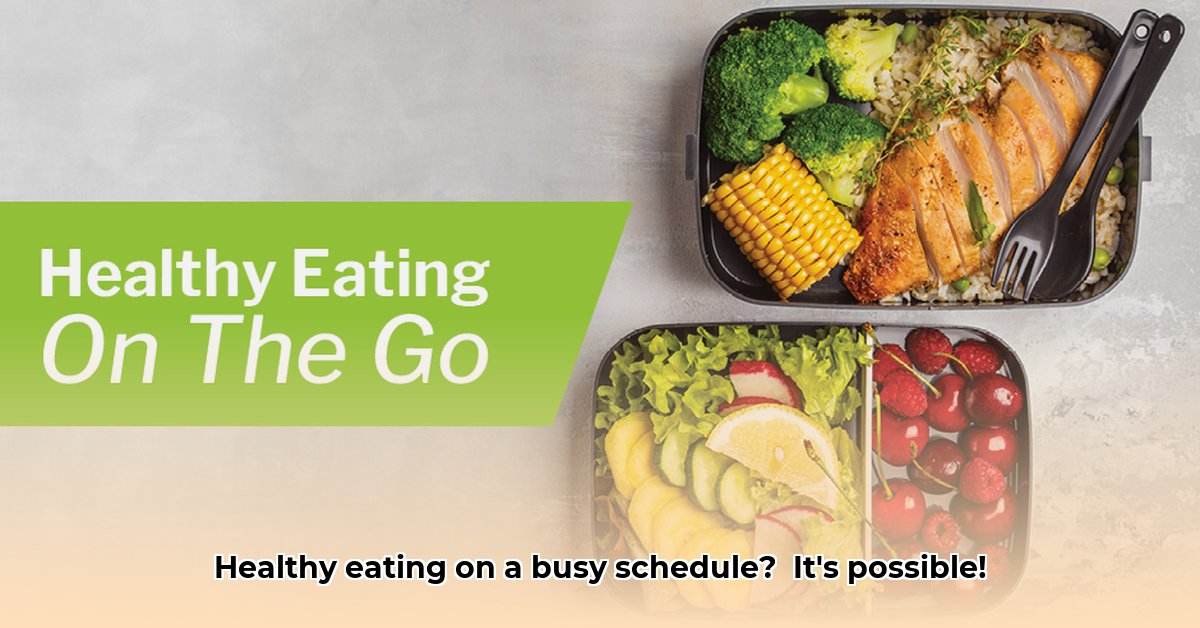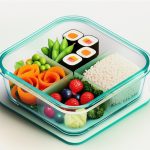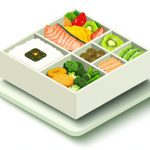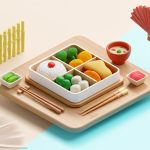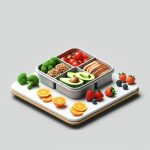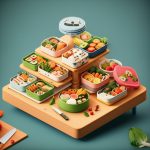Simple Strategies for Healthy Eating On the Go
Life gets hectic, and healthy eating often feels like a distant dream. But it doesn’t have to be! This guide offers simple, actionable steps to help you eat well, even when your schedule is packed. Let’s explore some strategies for success, designed to fit seamlessly into your busy life. For more in-depth guidance, check out these healthy eating books.
Mastering Meal Prep (Without the Kitchen Burnout)
Meal prep is a game-changer for busy individuals, but it doesn’t require spending hours in the kitchen. The key is smart, simple strategies and realistic goals. Plan ahead, prep efficiently, and portion your meals for ultimate grab-and-go convenience.
- Strategic Weekly Menu Planning: Dedicate 15-20 minutes each week to plan your meals for breakfast, lunch, dinner, and snacks. Use a meal planning app (like Plan to Eat or Mealime), a notebook, or even sticky notes – the method doesn’t matter as long as you have a plan. Consider theme nights (Taco Tuesday, Pasta Wednesday) to simplify decision-making.
- Efficient Prep Techniques: Wash, chop, and cook ingredients in advance. Sunday afternoon is ideal for many, but find a time that works for your schedule. Roast a large batch of versatile veggies (broccoli, sweet potatoes, bell peppers), cook a pot of quinoa or brown rice, or prepare a hearty soup or chili. Double recipes and freeze half for future meals.
- Portion Control & Smart Packing: Divide your prepped creations into individual containers for easily accessible and healthy lunches and snacks. Invest in a set of high-quality, reusable containers (glass or BPA-free plastic) for durability and easy cleaning. Clearly label containers with the contents and date to ensure freshness. Store properly in the refrigerator or freezer.
- Leverage Leftovers: Purposefully cook extra at dinner to create ready-to-go lunches the following day. Repurpose leftovers into entirely new dishes.
Healthy Snacking to Combat Hunger Pangs
Hunger can strike unexpectedly, especially when you’re on the go. Keep healthy snacks readily available to stay on track and avoid unhealthy impulse purchases. Choose snacks that not only satisfy cravings but also provide sustained energy and essential nutrients. Consider these options:
| Snack Option | Benefits | Tasty Examples |
|---|---|---|
| Protein & Fiber | Keeps you feeling full and energized for an extended period; aids in blood sugar stabilization. | Greek yogurt with berries and a sprinkle of nuts; a small handful of trail mix; hard-boiled eggs with a dash of pepper; edamame pods. |
| Fruits & Vegetables | Packed with vitamins, minerals, antioxidants, and fiber; provides natural sweetness and hydration. | Apple slices with almond butter; baby carrots with hummus; a handful of grapes; sliced bell peppers with guacamole; a small orange. |
| Whole Grains | Offers sustained energy release due to complex carbohydrates; provides fiber for digestive health. | Whole-grain crackers with avocado; a small whole-wheat tortilla with black beans and salsa; air-popped popcorn; a brown rice cake with a smear of peanut butter. |
| Healthy Fats | Promotes satiety, supports hormone production, and provides essential fatty acids. | A small avocado; a tablespoon of chia seeds added to yogurt or oatmeal; a handful of almonds or walnuts; a small serving of olives. |
Restaurant Survival Techniques: Navigating Menus with Confidence
Eating out doesn’t have to derail your healthy eating efforts. You can make nutritious choices, even at fast-food restaurants, by becoming a savvy menu detective and employing strategic ordering techniques.
- Become a Menu Intelligence Expert: Prioritize grilled, baked, roasted, or steamed options over fried items. Opt for whole grains (brown rice, quinoa, whole-wheat bread) over refined grains (white rice, white bread). Scrutinize the descriptions – be wary of words like “creamy,” “smothered,” or “loaded.”
- Order with Purpose & Intention: Load up on vegetables! Request extra salad (dressing on the side), steamed vegetables as a side dish, or add vegetables to your entree. Don’t hesitate to customize your order to align with your dietary needs and preferences. Request modifications, such as “no added salt” or “light sauce.”
- Portion Control Mastery: Share a meal with a friend or dining companion, immediately pack half of your meal to-go for another day to avoid overeating. Be mindful of portion sizes and stop eating when you feel satisfied, not overly full.
- Make Informed Drink Choices: Avoid sugary drinks like soda, juice, and sweetened iced tea. Choose water, unsweetened tea, sparkling water with lemon, or a diet soda.
Hydration: Your Secret Weapon for Healthy Eating and Overall Well-being
Dehydration can often be mistaken for hunger, leading to unnecessary snacking and overeating. Keep a reusable water bottle filled with water and readily accessible throughout the day. This simple habit can help curb mindless snacking, boost energy levels, and is essential for overall health.
- Set Hydration Goals: Determine how much water you need to drink daily (a general guideline is half your body weight in ounces). Use a marked water bottle or a hydration tracking app to monitor your intake.
- Add Flavor (Naturally): Infuse your water with slices of lemon, lime, cucumber, or berries for added flavor and enjoyment. Experiment with different combinations to find your favorites.
- Hydrate Before Meals: Drinking a glass of water 30 minutes before meals can help you feel fuller and eat less.
- Carry a Reusable Water Bottle: Bring a reusable water bottle with you wherever you go.
Personalizing Your Healthy Eating Journey
What works optimally for one person might not work effectively for another. Experiment with different strategies, recipes, and meal plans to discover what fits your unique lifestyle, preferences, and schedule. Healthy eating on the go is a personalized journey, so celebrate your successes, learn constructively from slip-ups, and always be kind to yourself.
How to Portion Control Healthy Meals for Busy Lifestyles
Key Takeaways:
- Strategic meal planning helps manage both time and caloric intake effectively. Prepping meals and snacks proactively prevents unhealthy impulse choices.
- Prioritize nutrient-dense foods (such as lean proteins, fiber-rich produce, and whole grains) for sustained energy and optimal health.
- Effective portion control involves utilizing smaller plates, accurately measuring food servings, and learning visual cues for appropriate serving sizes.
- Adapt meal plans dynamically based on your constantly evolving daily schedule and commitments.
- Leverage mobile apps for streamlined meal planning, detailed nutritional tracking, and a vast repository of healthy recipe ideas.
Mastering Meal Prep: Your Secret Weapon for Success
Life’s demanding pace often makes finding time for healthy eating seem like an insurmountable challenge. However, strategic meal preparation provides a simple yet powerful solution. By investing a little time upfront, you can proactively avoid the pervasive temptations of unhealthy takeout options and convenience foods.
- Plan Your Meals Thoughtfully: Dedicate approximately 30 minutes each week to meticulously plan your upcoming meals and snacks. This proactive approach effectively prevents last-minute, impulsive, and often unhealthy food choices.
- Batch Cooking Techniques: Utilize batch cooking techniques to efficiently prepare substantial quantities of grains, proteins, and vegetables on the weekend. This creates a ready-to-eat foundation for several pre-prepped lunches or dinners throughout the week.
- Portion Strategically: Upon completion of the cooking process, carefully divide the meals into individual containers for seamless and healthy meal consumption.
Smart Snacking: Fueling Your Day the Right Way
Strategic snacking serves to keep hunger at bay and effectively prevents overeating during subsequent mealtimes.
- Choose Strategically Nutrient-Dense Snacks: Select snacks that are inherently rich in essential nutrients, such as fruits, vegetables, nuts, or yogurt. These options provide sustained energy without the undesirable sugar crash often associated with processed snacks.
- Pre-Portion Snacks for Controlled Consumption: Take the proactive step of packaging snacks into individual bags or containers to prevent overindulging and promote mindful consumption.
- Cultivate a Mindful Approach: Pay close attention to your body’s innate hunger cues. Differentiate between genuine physiological hunger and emotional triggers such as boredom or stress.
Conquering Portion Control: Simple Tricks
Portion control doesn’t always necessitate strict calorie counting.
- Utilize Smaller Plates: Harness the power of visual cues by using smaller plates, which can effectively trick the mind and naturally reduce portion sizes.
- Measure Food Portions: Employ measuring cups and spoons to gain a practical understanding of appropriate portion sizes for various food items.
- Learn Visual Cues: Associate specific food items with familiar objects to estimate portion sizes accurately. For example, a deck of cards can represent a serving of meat.
- Tune Into Your Body: Develop a heightened awareness of your body’s satiety signals. Stop eating when you feel comfortably satisfied, rather than overly full or stuffed.
Leveraging Technology: Your Healthy Eating Ally
Technology presents a powerful ally in the pursuit of healthy eating habits.
- Utilize Meal Planning Apps: Explore a wide array of meal planning applications, many of which offer pre-made meal plans, diverse recipe ideas, and comprehensive calorie trackers.
- **Embrace Grocery Delivery
- Bento Box Glass Offers Practical, Eco-Friendly Meal Storage - December 16, 2025
- The Best Bento Box Price For Your Perfect Packed Lunch - December 15, 2025
- Bento Box Shopping Tips for Smart and Stylish Lunch Prep - December 14, 2025
